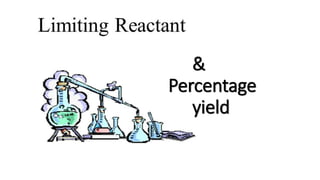
Quantitative aspect of Stoichiometry
- 2. Lesson Objectives By the end of the lesson learners should be able to: • To define the concept of limiting reactants • To learn to recognize the limiting reactant in a reaction • To use the limiting reactant to do stoichiometric calculations • To calculate percent yield
- 5. Limiting Reactants • Available Ingredients – 4 slices of bread – 1 jar of peanut butter – 1/2 jar of jelly • Limiting Reactant – bread • Excess Reactants – peanut butter and jelly Courtesy Christy Johannesson www.nisd.net/communicationsarts/pages/chem
- 6. Limiting Reactants • Limiting Reactant – used up in a reaction – determines the amount of product • Excess Reactant – added to ensure that the other reactant is completely used up – cheaper & easier to recycle Courtesy Christy Johannesson www.nisd.net/communicationsarts/pages/chem
- 7. Stoichiometry Like many problems in chemistry, there are multiple ways of solving these problems. You can save yourself some work, by first identifying what you need to solve for and then choosing the appropriate method. Don’t worry if you choose the wrong method, you’ll get to the correct answer, it will just take you a few more steps.
- 8. Limiting Reactants – Method 1. Write a balanced equation. 2. For each reactant, calculate the amount of product formed. 3. Smaller answer indicates: – limiting reactant – amount of product Courtesy Christy Johannesson www.nisd.net/communicationsarts/pages/chem
- 9. Limiting Reactants – Method 2 • Begin by writing a correctly balanced chemical equation • Write down all quantitative values under equation (include units) • Convert ALL reactants to units of moles • Divide by the coefficient in front of each reactant • The smallest value is the limiting reactant!
- 10. Limiting Reactants aluminum + chlorine gas aluminum chloride Al(s) + Cl2(g) AlCl3 2 Al(s) + 3 Cl2(g) 2 AlCl3 100 g 100 g ? g A. 200 g B. 125 g C. 667 g D. 494 g
- 11. Limiting Reactants aluminum + chlorine gas aluminum chloride 2 Al(s) + 3 Cl2(g) 2 AlCl3 100 g 100 g x g Al AlCl3 x g AlCl3 = 100 g Al 27 g Al = 494 g AlCl3 1 mol Al 2 mol AlCl3 2 mol Al 133.5 g AlCl3 1 mol AlCl3 How much product would be made if we begin with 100 g of aluminum? Cl2 AlCl3 x g AlCl3 = 100 g Cl2 71 g Cl2 = 125 g AlCl3 1 mol Cl2 2 mol AlCl3 3 mol Cl2 133.5 g AlCl3 1 mol AlCl3 How much product would be made if we begin with 100 g of chlorine gas?
- 12. 12 Limiting/Excess/ Reactant and Theoretical Yield Problems : Potassium superoxide, KO2, is used in rebreathing gas masks to generate oxygen. 4KO2(s) + 2H2O(l) 4KOH(s) + 3O2(g) a. How many moles of O2 can be produced from 0.15 mol KO2 and 0.10 mol H2O? b. Determine the limiting reactant. 4KO2(s) + 2H2O(l) 4KOH(s) + 3O2(g) First copy down the the BALANCED equation! Now place numerical the information below the compounds.
- 13. 13 Limiting/Excess/ Reactant and Theoretical Yield Problems : Potassium superoxide, KO2, is used in rebreathing gas masks to generate oxygen. 4KO2(s) + 2H2O(l) 4KOH(s) + 3O2(g) a. How many moles of O2 can be produced from 0.15 mol KO2 and 0.10 mol H2O? b. Determine the limiting reactant. 4KO2(s) + 2H2O(l) 4KOH(s) + 3O2(g) 0.15 mol 0.10 mol ? moles Two starting amounts? Where do we start? Hide one
- 14. 14 Limiting/Excess/ Reactant and Theoretical Yield Problems : Potassium superoxide, KO2, is used in rebreathing gas masks to generate oxygen. 4KO2(s) + 2H2O(l) 4KOH(s) + 3O2(g) a. How many moles of O2 can be produced from 0.15 mol KO2 and 0.10 mol H2O? b. Determine the limiting reactant. 4KO2(s) + 2H2O(l) 4KOH(s) + 3O2(g) 0.15 mol 0.10 mol ? moles Hide Based on: KO2 0.15 mol KO2 4 mol KO2 2 mol H2O = 0.075 mol H2O are needed 4KO2(s) + 2H2O(l) 4KOH(s) + 3O2(g) 0.15 mol 0.10 mol We calculated that we need 0.075 moles of water, but we have 0.10 moles, thus water is in excess, thus our limiting reactant is KO2
- 15. 15 Potassium superoxide, KO2, is used in rebreathing gas masks to generate oxygen. 4KO2(s) + 2H2O(l) 4KOH(s) + 3O2(g) a. How many moles of O2 can be produced from 0.15 mol KO2 and 0.10 mol H2O? b. Determine the limiting reactant. KO2(s) c. Determine the moles of oxygen produced 4KO2(s) + 2H2O(l) 4KOH(s) + 3O2(g) 0.15 mol excess ? moles Based on: KO2 = mol O2 0.15 mol KO2 2 2 KO 4mol O mol 3 0.1125 Limiting/Excess/ Reactant and Theoretical Yield Problems :
- 16. Percent Yield • The percent yield is a measure of the efficiency of a reaction carried out in the laboratory. • A batting average is actually a percent yield. 12.3
- 17. Percent Yield – The theoretical yield is the maximum amount of product that could be formed from given amounts of reactants. – The actual yield mass that is always given in a question or statement 12.3
- 18. 12.9 Calculating Theoretical Yield is just Mass:Mass!!!!!!!!
- 19. 12.9
- 20. 12.9
- 22. Concept Map 12 • Solve the Concept Map with the help of an interactive guided tutorial.
- 23. Conclusion N₂+ 3H2=2NH3 You are given 28g of N, and 10g of H Mass from periodic table: N=14 H=1 A) Determine the limiting reagent B) Determine the mass of NH3 ,that will be produced C) A student tries this reaction in a lab and only manages to produce 15g of NH3. What is the percentage yield?
- 24. . END OF SHOW
